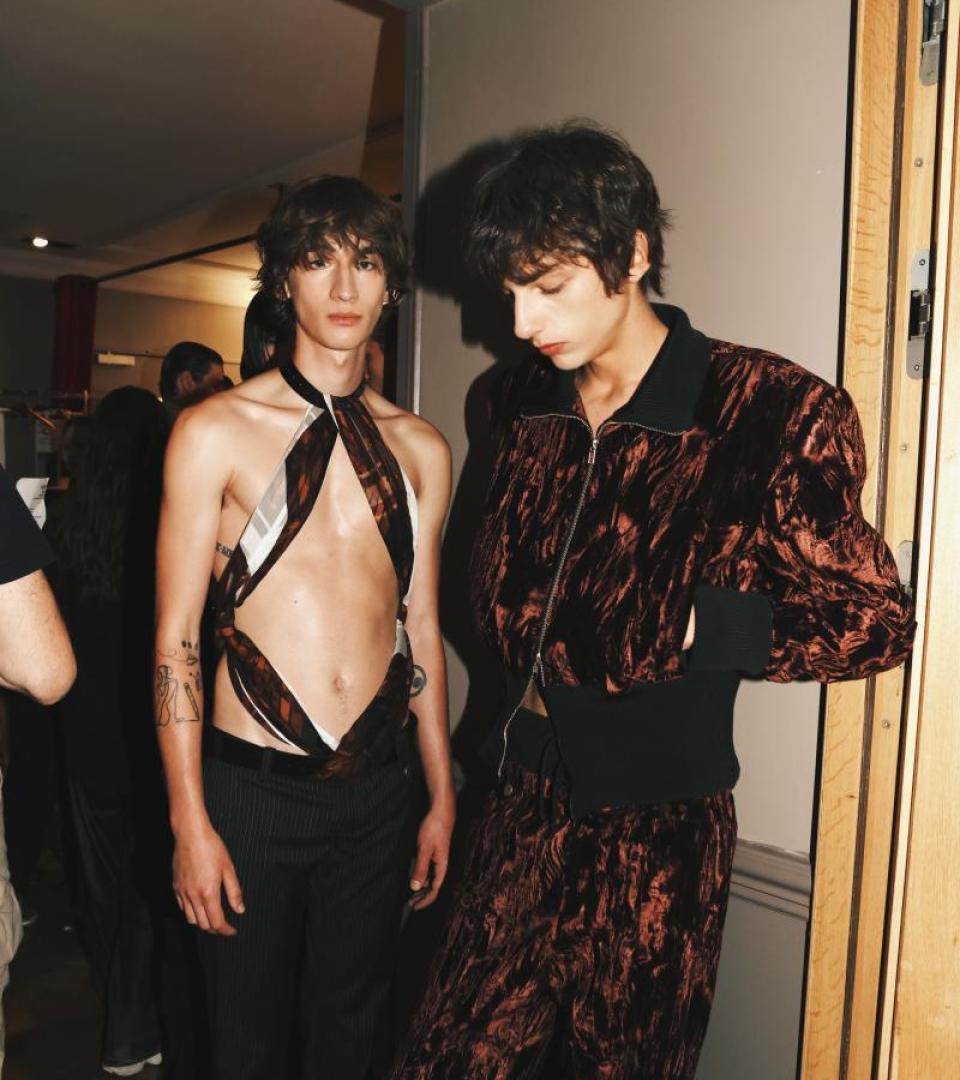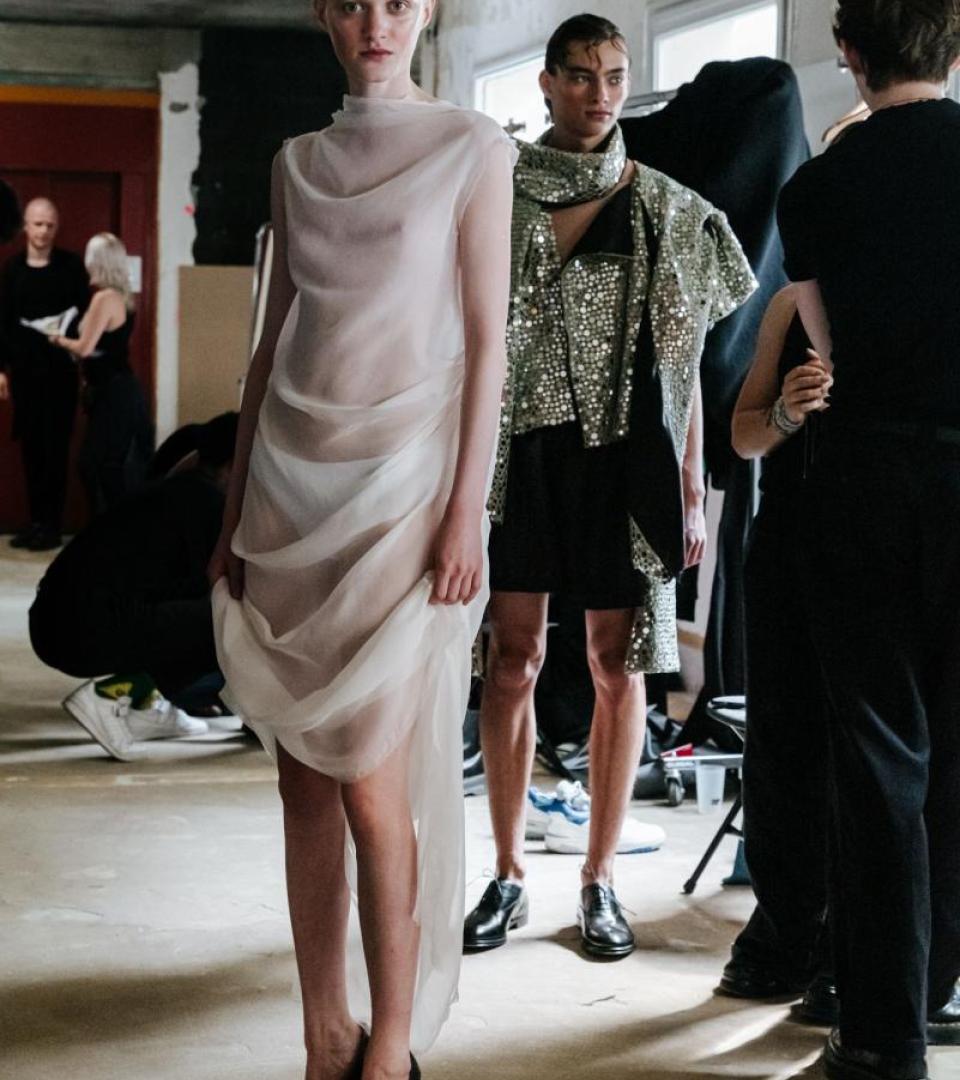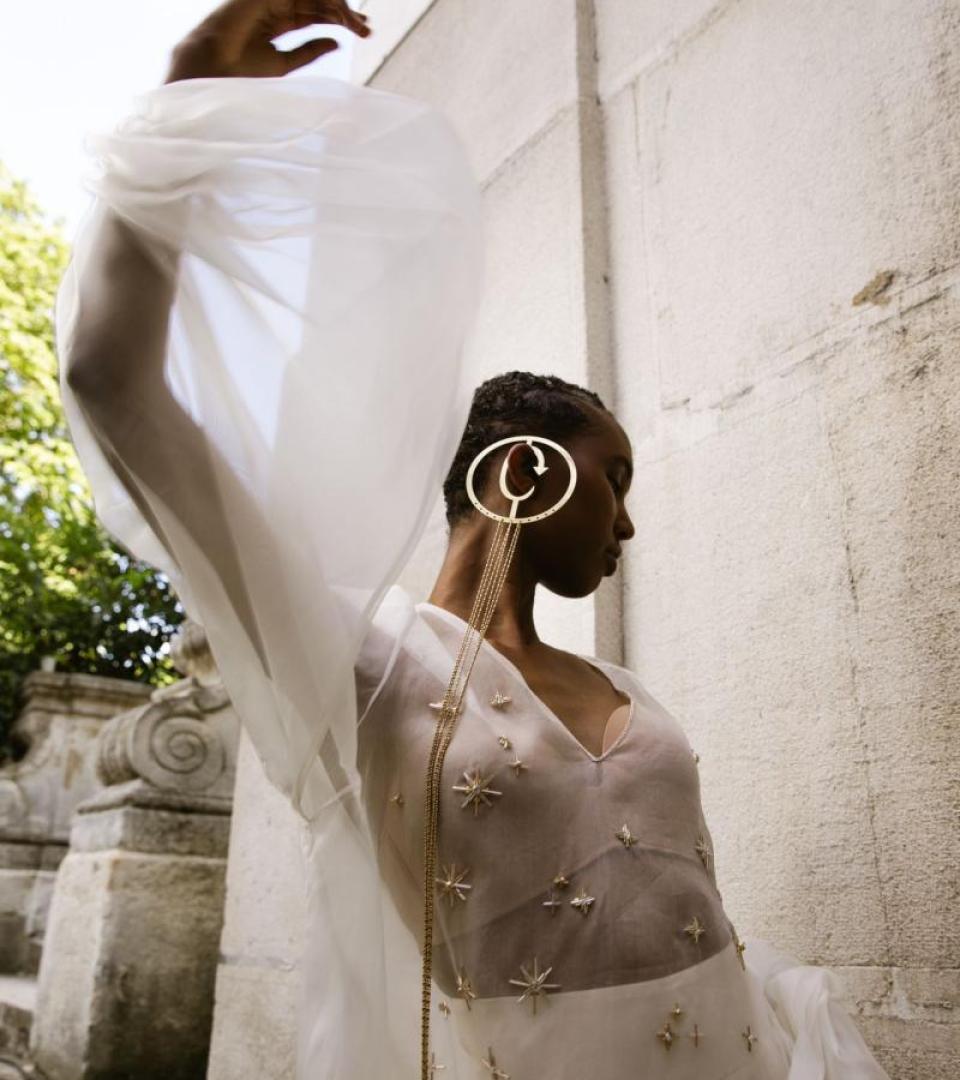50 years of Paris Fashion Week® through the eyes of Carla Sozzani
Her friend Azzedine Alaïa called her ‘the most interesting woman in Italy’: Carla Sozzani has been working in fashion for more than six decades, forging bridges between the arts and culture. A pioneer of the concept store and curator of 300-plus exhibitions, the current president of the Azzedine Alaïa Foundation looks back on a series of shows that revolutionised and defined Paris Fashion Week®, drawing a vivid portrait of Paris as a cosmopolitan fashion capital.
Sozzani, who smiles at the aforementioned description, defines herself first and foremost as an editor. From 1968 to 1976, she was an editor for several fashion magazines; then editor-in-chief of special issues of Vogue Italia (1976-1986), which from 1988 was run by her sister Franca Sozzani, making fashion history with its directional editorials. Carla co-founded the Italian version of Elle in 1987 but was let go after a year for refusing to bow to advertisers. Gentle and adamant, sensitive to the artists she constantly defended, she went on to found her own publishing house, Carla Sozzani Editore S.r.l., and in 1990 opened the concept store 10 Corso Como. A unique experience combining photography and design exhibitions, a bookshop and a café, this concept store is now considered a pioneer. From Kenzo to Nicolas Ghesquière, via Claude Montana and Rei Kawakubo, and of course, her dear friend Azzedine, she looks back on her experience of fashion in Paris.
You began your career in 1968, a period marked by social and cultural upheaval, but also by the transformation of the Paris fashion scene. Under the impetus of Didier Grumbach, alliances between designers and industry multiplied, and new designers came up with silhouettes that challenged the codes of Haute Couture – André Courrèges and Paco Rabanne among others.
Carla Sozzani: The Jacobsons with Dorothée Bis, who received guests at the former Piscine du Lutetia; Emmanuelle Khanh or Daniel Hechter at the Louvre: there was a very strong shift that hadn't occurred in Italy. In Milan, ready-to-wear was just beginning. The first Yves Saint Laurent Rive Gauche shop opened in 1967 and everyone went there. Miuccia Prada wore Saint Laurent from head to toe! Everyone wanted to come to Paris and experience the excitement.
The first fashion show I went to, in 1969, was still Haute Couture. At the time, I went with the Italian Vogue team for the special Couture issues. The shows were aimed at wealthy women, but times were changing: accessible fashion, open to all, was arriving. We were moving from decadent Couture to a model that did not yet exist: ready-to-wear. In the streets of Paris, it was already there: I remember very well the Courrèges boutique, opened in 1967, located at 40 rue François 1er. At the time, the most beautiful boutique in the world. I also went to the Saint Laurent Rive Gauche boutiques, especially the one with factory prices on rue d'Aboukir, opened by Didier Grumbach, where all the women editors rushed. I was there in January 1971 for the ‘40’ collection, which later became the ‘Scandale’ collection. I was a junior editor, and I was standing at the back, on a magnificent staircase, next to Manolo Blahnik. I found this re-reading magnificent.
You weren't shocked?
CS: No, not at all! I was blown away by the silhouettes. I even wore one of the red suits to my sister’s wedding. Things were changing! My first big crush was on Kenzo. As soon as I arrived in Paris, I would stop off at the Place des Victoires boutique, and I wasn't the only one! His fashion shows at the Bourse du Commerce were incredible: people stood up and applauded like children. The flowers, Pat Cleveland, the children on the catwalk – it was joie de vivre. With Kenzo, everything was a party, and he lived the party. He organised parties at the Palace! He had, I don't know how many, farewell shows – each more spectacular than the last. I remember a girl on a white horse at the Cirque d'Hiver (1983) and a party with dozens of different cuisines: Chinese, Italian, French, Thai. He loved these performances but could also switch to more intimate formats. At Place des Victoires, in a more relaxed and informal atmosphere, he brought together groups of journalists for lunches, tea… There were always spectacular performances going on in Paris in general. Everyone wanted to get into the shows and take photos. There were no limousines yet and people were drawing what they saw. The editor of American Vogue, Grace Coddington, went everywhere with her Smythson sketchbook. People went to the Café de Flore, Brasserie Lipp or the Café Voltaire and onward to the Bains Douches or the Palace. Everyone met up and the photographers were more and more numerous, as were the journalists. Some were regulars, absolute stars who had to be read: Francine Crescent (editor-in-chief of Vogue Paris from 1961 to 1984) and Hebe Dorsey for the Herald Tribune. I lived in a private mansion on rue du Bac, and every morning I read Hebe Dorsey over breakfast. You couldn't go to a fashion show without reading the reviews. It didn't even exist. It was essential reading! And that's normal: fashion was a discovery, you had to be informed!
Another very important name for me at the time was Claude Montana, the opposite of Kenzo. His shows were very serious and dramatic, and the clothes were truly sublime. He left his mark on fashion at the time, and we mustn't forget that. Then there was Thierry Mugler, who was even more spectacular, if you like. There was a spirit, a cut. With him, the fashion shows went to another level. The climax? The March 1995 show at Le Zénith. Over 5,000 spectators, I think. It was unprecedented. Fashion had changed: it was no longer restricted and closed as in the days of Couture. The catwalk shows were also evolving, attracting more and more people from all over the world. You could easily be 700, which was unthinkable before 1973. The new designers had nothing to lose, so the shows were incredible. But life wasn’t easy. They sacrificed everything for fashion because they had so much to say. That’s why they became so famous and had such strong personalities. Paris brought them together. The city’s strength was its variety, its openness to differences – and this is true today.
In the end, there was just such variety.
CS: Yes, all of a sudden there was a lot of choice. Sonia Rykiel was incredible with her knitwear. Her fashion shows had been staged since 1968 in her boutique in Saint-Germain-des-Prés, rue de Grenelle. There were always poetry readings. And then, there was Chloé by Karl Lagerfeld, where I met Patrick Hourcade, and his muse at the time, the Italian journalist Anna Piaggi, wearing incredible outfits. At the end of the 1970s, I met Azzedine Alaïa. It was still his leather era, and we had devoted several pages to him in Vogue Italia. We became close friends and our relationship grew over the years. He was close to my daughter, my nephew, my sister; we were like family.
In 2002, you worked with Rei Kawakubo to open the 10 Corso Como / Comme des Garçons shop in Tokyo. The same year, through your publishing house, you released Yohji Yamamoto: Talking to Myself, in which Yamamoto talks about many subjects, including his relationship with design. What role did these two designers play in your experience of fashion in Paris?
CS: It was a real shock. I remember very well Yohji Yamamoto’s first show in 1981, and perhaps even more so Rei Kawakubo’s show for Comme des Garçons. I was still dressing a lot in Montana, and when I saw the first Comme des Garçons collection, I realised that this was the woman I wanted to be, but I didn't know it. It was difficult to understand. Back then, women weren’t so free. When I saw Comme des Garçons, I said: “Now that's freedom.” No make-up, no heels: it was a revolution. Rei Kawakubo was proposing a different way of being a woman. Strong, without having to be aggressive – and that shook up all the codes. I was also close to Azzedine at the time, and I dressed in his clothes, always mixing them with Comme des Garçons. And I still do!
Other emerging designers were noteworthy including Gaultier starting in 1976. I think I went to every show. They were real analyses of the times, a kind of sociology. The men’s collections were incredible: it was really the first one about men, it was like a liberation. Men, women: there were no more questions. I wanted to see all his shows, because every time I did, it was a new discovery and there was never a dull moment.
My other big shock was Margiela in 1989. I was at the Café de la Gare for the first presentation. It was very different, like a mirror of society. It wasn't just fashion: it told something about the times. It was very natural, and there was this whole concept of recycling. If you go back, Poiret had already done it before anyone else; but with Margiela's Replica lines, recycling and uniqueness were linked. I remember a fashion show made up of crumpled dresses found at flea markets. If you bought them, you never bought the same one. They took us to places that were always incredible: garages, sex shops. Once, he showed just after Rei Kawakubo at the Salle Wagram. The public got to see these two collections back-to-back.
We often read that, from this time onwards, fashion shows became increasingly shorter. Designers were trying to convey a state of mind.
CS: Some were still long. I remember a multi-act Yves Saint Laurent show that must have broken records. But, generally speaking, we went from a half-hour to 15 minutes, which was a bit strange, because sometimes it takes an hour to get to a place, then you have to wait 40 minutes for a ten-minute show. But those were the days!
In the 1980s, new magazines borrowing the codes of fanzines appeared in England. Did this change the population at fashion shows?
CS: There was Details magazine with Bill Cunningham, who took all the photos for the shows, but also i-D with Terry Jones, or The Face. My sister also edited Lei magazine (1980-1988). These titles were not tied to advertising and had much more editorial freedom. And, of course, the wonderful La Mode en peinture d'Assouline, edited by Sylvie Grumbach (1982-1987), which was sold at fashion shows, was a must.
All sorts of upheavals returned during the 1990s and 2000s, such as the arrival of the major groups. What were the highlights for you?
CS: Margiela really struck me, and after him, it was difficult. Let’s just say that a designer like Margiela doesn’t come along every day. There were Galliano and McQueen, two exceptional designers. Galliano put on the craziest, most magnificent shows. As for McQueen, I remember crying at the Voss collection presented in Paris in October 2004. It featured a life-size chess set. I was overwhelmed: he was touching intimate chords. Seeing a fashion show is sometimes like going to the movies. It’s so beautiful; it brings tears to your eyes. You remember it for a long time and dream about it.
In the 1990s, I also went to see Helmut Lang’s collections. I went to the first presentation in 1986 with Jean-Jacques Picart and his wife Nicole, editor-in-chief of Madame Figaro. He made his Austrian jackets with small buttons. I later introduced him to an Italian group. His work was exceptional, and he’s a very independent thinker.
The 2000s were marked by many transformations: the end of Saint Laurent by Saint Laurent and the arrival of new designers. I really liked Nicolas Ghesquière, who arrived in 1997 at Balenciaga, where he stayed until 2012. These were truly the most beautiful collections of the decade, with incredible excitement in the room. People wanted to see his proposals. I remember the Spring-Summer 2008 collection: very 18th century, magnificent. There was another with very sculpted dresses. And the first one, which was all grey, burgundy and black, a bit Victorian – perhaps the most beautiful.
What about today?
CS: Well, I don’t go to the shows as much, but I’m still interested. I love Duran Lantink, for example! Paris is still a gateway to other worlds! It's hard not to forget someone, but it’s true that I've met a lot of designers, or rather artists, who express themselves in the world through clothing.
By Manon Renault.
This interview has been lightly edited.



